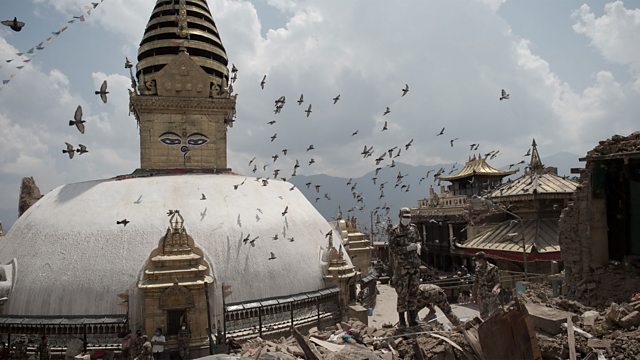The Destructive Power of the Nepalese Earthquake
The destructive potential of earthquakes, How insects are solving crimes and revealing hidden histories, Exploring the acoustics of icy waters, Protecting the origins of stones.
Despite the recent 7.8 magnitude earthquake in Nepal having caused widespread destruction, video evidence of the shaking has shown that the tremors were significantly slower than would be expected. Seismologist Susan Hough from the US Geological Survey tells Roland Pease why the figures on the Moment Magnitude scale are not the only way to measure the extent of earthquake damage. Susan also explains how the earthquake has not been nearly as catastrophic as was feared.
Crime Solving Insects
When a dead body is found in suspicious circumstances there are a variety of tools that forensic scientists can use to determine how the person died. But some of the most revealing information is contained in the maggots, beetles and other insects that are associated with the body. Roland Pease speaks to Italian forensic entomologist Dr Stefano Vanin to find out how insects have been thwarting the Italian mafia, reuniting lost bodies with their families and revealing how ancient Columbians lived.
Ice Acoustics
Whilst appearing calm and serene, the waters found under ice contain many unusual and ephemeral sounds, from vehicle motors to the creaking of moving ice. Andrew Barnard from Michigan Tech in the US, has spent the winter capturing these sounds with hydrophones - underwater microphones. He explains how studying underwater acoustics can help us understand and mitigate the sonic impact of humans on the underwater ecology, as well as decipher the sounds made by ice itself.
Authenticating Stone
For many food fans, and gastronomes, knowing which region a product comes from is key to assuring its quality and consistency. These needs have helped drive a global system of legal protection for products like Champagne wine and Parmesan cheese. Now, there are plans to authenticate and legally recognise regionally derived building stone. Βι¶ΉΤΌΕΔ Science correspondent Jonathan Amos reports on why knowing where your stone comes from can make a difference to building and business.
(Photo: Nepalese soldiers clear the rubble of the damaged Swayambhunath temple in Kathmandu, following a 7.8 magnitude earthquake which struck the Himalayan nation on 25 April 2015 Β© Nicolas Asfouri/AFP/Getty Images)
Last on
More episodes
Previous
Broadcast
- Thu 7 May 2015 18:32GMTΒι¶ΉΤΌΕΔ World Service Online
Podcast
-
![]()
Science In Action
The Βι¶ΉΤΌΕΔ brings you all the week's science news.


